Sally Hawkins The Shape of Water

Circa 1963
Cast: Sally Hawkins, Doug Jones, Michael Shannon, Michael Stuhlbarg, Octavia Spencer, Richard Jenkins
Director: Guillermo del Toro
Genre: Drama, Fantasy
Rated: MA15+
Running Time: 123 minutes
Synopsis: From master story teller, Guillermo del Toro, comes The Shape of Water - an other-worldly fairy tale, set against the backdrop of Cold War era America circa 1962. In the hidden high-security government laboratory where she works, lonely Elisa (Sally Hawkins) is trapped in a life of isolation. Elisa's life is changed forever when she and co-worker Zelda (Octavia Spencer) discover a secret classified experiment. Rounding out the cast are Michael Shannon, Richard Jenkins, Doug Jones and Michael Stuhlbarg.
The Shape of Water
Release Date: January 18th, 2018
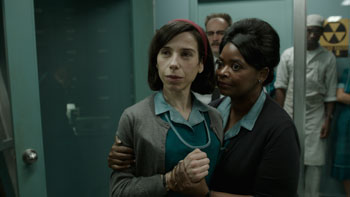 About The Production
About The Production
'Water takes the shape of whatever is holding it at the time and although water can be so gentle, it's also the most powerful and malleable force in the universe. That's also love, isn't it? It doesn't matter what shape we put love into, it becomes that, whether it's man, woman or creature." - Guillermo del Toro on The Shape Of Water
In a secret government laboratory at the height of the Cold War, a visually dazzling, emotionally daring feat of the imagination erupts. Master storyteller Guillermo Del Toro casts an other-worldly spell with The Shape Of Water, merging the pathos and thrills of the classic monster movie tradition with shadowy film noir, then stirring in the heat of a love story like no other to explore the fantasies we all flirt with, the mysteries we can't control and the monstrosities we must confront.
Guillermo del Toro opens his tale deep underwater. From there the entire film becomes an act of breathless submersion, plunging the audience into a 1960s world full of things we recognise – power, anger, intolerance; as well as loneliness, determination and sudden, electrifying connections – and one extraordinary creature we do not. An inexplicable biological 'asset" of the U.S. government, a mute cleaning woman, her loving best friends, Soviet spies and an audacious theft all flow into a singular romance that surges beyond all boundaries.
This mystery-shrouded amphibious being has not only been hauled up from the dark, watery depths, but seems to have the fundamental adaptive qualities of water – taking on the psychic contours of every human he encounters, reflecting back both aggression and fathomless love.
Within Guillermo del Toro's storytelling, the themes of good and evil, innocence and menace, the historical and the eternal, beauty and monstrosity weave in and out of each other, revealing that no darkness can ever fully defeat the light. Summarises Guillermo del Toro: 'I like to make movies that are liberating, that say it's okay to be whoever you are, and it seems that at this time, this is very pertinent." It was also paramount that there be an extraordinary collection of actors.
For Guillermo del Toro, the passion for simultaneously haunting and enchanting audiences goes back a long way. A native of Guadalajara, Mexico, he nourished himself as a boy on the infinite mysteries of ghost stories, monster movies and fables that ignited his own wildly inventive interior fantasy life. When he started writing and directing films, all those influences twined into a viscerally expressive visual style all his own, one that seemed to tap directly into the human psyche.
Guillermo del Toro is best renowned for his three inspired Spanish-language films that reinvent and upend the very notion of genre: the multiple Oscar®-winning Pan's Labyrinth, Cronos, and The Devil's Backbone. Each a vivid phantasmagoria navigating the moral and physical dangers of a world of corruption, authoritarianism and war.
His supernatural action epics are equally as inventive – Blade II, the Hellboy series, and Pacific Rim, as well as his gothic romance Crimson Peak.
The Shape Of Water follows in that tradition, but this time in socially divided 1960s America on the brink of nuclear war and sweeping cultural changes. Guillermo del Toro weaves in the dizzying landscape of falling in love, as a lonely woman with a traumatic past discovers a love so overpowering it defies suspicion, fear and biology.
Guillermo del Toro also assembled an extraordinary collection of actors for the film. The talented ensemble includes Sally Hawkins, Michael Shannon, Richard Jenkins, Doug Jones, Michael Stuhlbarg and Octavia Spencer. Exploring the idea of love and its barriers, internal and external, was paramount to Guillermo del Toro. 'I wanted to create a beautiful, elegant story about hope and redemption as an antidote to the cynicism of our times. I wanted this story to take the form of a fairytale in that you have a humble human being who stumbles into something grander and more transcendental than anything else in her life. And then I thought it would be a great idea to juxtapose that love against something as banal and evil as the hatred between nations, which is the Cold War, and the hatred between people due to race, color, ability and gender."
The fact that the film's two leads don't speak, not conventionally anyway, only heightens the love story by stripping away the miscommunications that often stand between humans. 'One thing about love is that it is so incredibly powerful, it doesn't require words," says Guillermo del Toro.
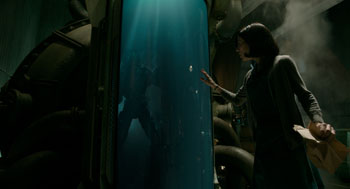 The Seduction Of Monster Movies
The Seduction Of Monster Movies Mixing many genres from lush musicals to suspenseful noir, The Shape Of Water particularly revisits and reinvigorates the enduring allure of the monster movie playing upon our most primal emotions of fear, abandonment and danger but also curiosity, awe and desire.
Like many, Guillermo del Toro grew up with the dark enchantment of the classic Universal Studios monsters: the Wolf Man who turned feral against his will, the naïve Frankenstein chased by angry townsfolk, the seductive Dracula driven by his unholy appetites, and the Creature from the Black Lagoon, an amphibious prehistoric creature who emerged from the sea longing for a companion.
There was something evocative and deeply, strangely relatable about these monsters. They were persecuted by pitchfork-bearing crowds because they were different and forced to skulk alone on the edges of society in remote castles, woods or rivers. All were trapped in a transitional state – part human, part other – which anyone who has felt ostracised can identify with. Perhaps most intriguingly, they were sensual beings, powerless to the unending needs of their bodies and minds.
Of all the iconic monsters, the most heartbreaking of all was the piscine amphibious humanoid from Creature From The Black Lagoon (1954). Directed by Jack Arnold and starring Ben Chapman (on land) and Ricou Browning (underwater) as the inimitably tragic Gill-Man, the last of his prehistoric species. At once dangerous and forlorn, reviled and yearning, the Creature touched audiences even as it scared them.
The Shape Of Water was conceived in 2011 when Guillermo del Toro and Daniel Kraus, the director's writing partner on his children's book series, Trollhunters, met for breakfast one morning. Daniel Kraus mentioned an idea he had had as a teenager, about a cleaning woman working in a government facility and secretly befriending an amphibious man being held captive as a specimen and how she decides to liberate him. Guillermo del Toro loved the idea so much that he immediately said he wanted it to be his next movie - it seemed the perfect sort of fairy tale idea he had been searching for. From that meeting, a deal was made for the pair to collaborate together on a novel and for del Toro to write and direct the film. At that point, Guillermo del Toro was still completing work on his giant-robot/monster blockbuster Pacific Rim, but in rare quiet moments, also drawing from classic monster films such as The Creature From The Black Lagoon, he'd spend time writing the script for the more intimate film that would eventually be called The Shape Of Water.
In 2014, Guillermo del Toro self-financed a group of artists and sculptors using designs and clay models to pitch the story from beginning to end to Fox Searchlight. The studio came on board immediately without any hesitation. The following spring, Guillermo del Toro and Fox Searchlight begin meeting with potential co-writers to work on the screenplay with him. They ultimately hired Vanessa Taylor who worked closely with Guillermo del Toro on both plot structure and character (particularly the multi-layered lead character Eliza).
Guillermo del Toro wanted to upend the conceit of monstrosity with a love story that surrenders fully to making the creature the lead and the human forces aligned against him the true forces of sinister darkness. 'In a monster movie of the 50s, Strickland, the square-jawed, good-looking government agent, would be the hero, and the creature would be the villain. I wanted to reverse those things."
Guillermo del Toro also decided to take his monster movie to a different level: the sensual. He wanted an earthiness to counterbalance the fairy tale and to bring it to the edge of a familiar adult reality.
For producer J. Miles Dale, who has collaborated with Guillermo del Toro for years, Guillermo del Toro is one of the few directors with the skill to create creatures that live and breathe with a fully expressed humanity we all recognise.
'Guillermo del Toro creates creatures uncorrupted by the ways of the human world. We can look at them as a kind of mirror to what we might be ideally," says J. Miles Dale. 'This film is not like anything you've seen before, but it also feels like a Guillermo del Toro movie. It's so clearly in his voice, but it's also new and original."
For the story's time period, Guillermo del Toro purposely chose an American era in which epic fears held sway: 1962, as anxiety over nuclear war with the Soviet Union was peaking, and just before the idealistic, future-focused Camelot of President Kennedy gave way to disillusion, mounting paranoia and social upheaval. 'There's a lot going on in that time period," says J. Miles Dale. 'There's the Cold war, the Space Race and the Civil Rights movement. And it's all the backdrop for a love story you haven't seen before."
The period is one that is sometimes glorified notes Guillermo del Toro, without remembering its injustices and stultifying dread of human differences. 'To me, this is a time when America stopped – it's a time of racism, of inequality, of people thinking about the brink of nuclear war. In a few months, Kennedy will be assassinated. So in a way, it's a horrible time for love," he comments, 'yet love happens."
The futuristic impulses of 60s America play off the primordial creature, recalling Rilke's words 'where something past comes again as if out of the future." Says Guillermo del Toro: 'What interested me is that 1962 is a time when everybody was focused on the future, while the creature is an ancient form of the deep past. People are obsessed with what's new, with ad jingles, the moon, modern clothes, TV. And in the meantime here's this ancient force, a creature in love, who comes among them."
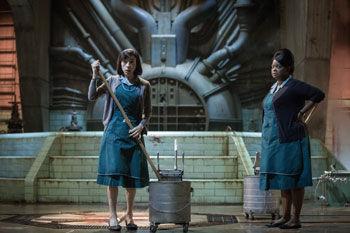 Casting The Net
Casting The Net Each of the roles in The Shape Of Water was written for a specific actor -- the very same actors who Guillermo del Toro asked to appear in the film. 'He was honing the script to their voices, rather than vice versa," comments J. Miles Dale," which is an exciting thing to be able to do."
Guillermo del Toro notes that each of the film's characters, no matter their place in society, is grappling with love in different circumstances. 'There's a pure love between Elisa and the creature, but government agent Strickland is also trying to love, though we experience that his love is brutal, and Elisa's neighbor Giles is looking for a love frowned upon in that time, and Elisa's best friend Zelda is in love with a man who does not deserve her love. Even the General overseeing the laboratory has a kind of father/son love story with Strickland."
As each was approached, all said yes. 'This is a very special film," says Sally Hawkins. 'Taking part in it has meant so much to me. It's a story that will forever have a piece of my heart."
Says Michael Shannon: 'I was drawn to the picture because I felt it could have hopeful qualities that might inspire people to be gentler with one another -- that's sorely missing right now. It's really a story about how it is worth having love in your life at any cost. Sometimes love requires you to face your fears, or to make sacrifices, but at the end of the day it's worth it."
For Richard Jenkins, the film went beyond even what audiences have come to expect from Guillermo del Toro. 'Guillermo del Toro's filmmaking is like no one else, but this film is also unlike any he's done before," he notes. Octavia Spencer was all but waiting for Del Toro's call. 'I had met him before I read the script and it felt like I've known him my entire life," Octavia Spencer recalls. 'As a filmmaker, he's just an alchemist. He turns human themes into something otherworldly."
Concludes Doug Jones, who has worked with Guillermo del Toro six times: 'In The Shape Of Water, Guillermo del Toro goes back to his artistic roots and lets all of his creative juices flow."
The Lonely Dreamer
'What propels Elisa into the unknown is the power of love."
- Sally Hawkins
The journey of Elisa from loneliness and powerlessness to a heroine who takes huge risks forms the beating heart of The Shape Of Water, made all the more extraordinary because the role is almost without words. Rendered mute by a childhood trauma, Elisa communicates in American Sign Language (ASL), but she is able to express herself effusively when she encounters the strange aquatic creature being warehoused in the government lab where she works as a cleaning lady.
Elisa's rich and brave interior world comes to life via a luminous performance from Academy Award® nominee Sally Hawkins that propels the story forward at every turn. 'I sent a message to Sally Hawkins in 2013 that I was writing this role for her, and when we met, she told me she had already been in the middle of writing a short story about a woman who becomes a fish," Guillermo del Toro recalls. 'She sent me her story and it was full of insights."
Sally Hawkins has played a wide variety of extraordinary and unique roles: an optimistic school teacher in Mike Leigh's Happy-Go-Lucky, garnering a Golden Globe Award; her Oscar®-nominated role as Cate Blanchett's working class sister in Woody Allen's Blue Jasmine; and most recently as real-life folk artist Maud Lewis in Maudie.
Sally Hawkins knew instantly there has never been and will never be a role quite like Elisa. 'It's so rare that you get a role that asks you to put it all out there. Where it's about unadulterated expression and words are not needed, and you have the freedom to express so much through your eyes, breath and body. That is Elisa."
Sally Hawkins was Guillermo del Toro's muse as he was writing. 'Elisa is not someone who had a horrible existence until the creature showed up. She was not leading a glamorous existence by any means but she was content. I needed someone who evokes that kind of happiness, whose face is able to express every hue without a word. Sally Hawkins has that kind of unique energy, so that is why I wrote it for her. Sally Hawkins is the most genuine, unaffected person and I don't think she is capable of doing anything that isn't emotionally real."
The first read of the script beckoned to Sally Hawkins so powerfully it sparked a few anxieties. 'It was so moving. It was interestingly familiar to me, yet it was like nothing I've encountered. I felt like Elisa was a deep part of me, or like I knew her in another life. I also felt it was the ultimate romantic fairy tale. At first I was convinced that Guillermo del Toro had the wrong person for the role," she confesses. 'It's the kind of romantic lead I really didn't ever think I would play, so it's been a dream gift to me."
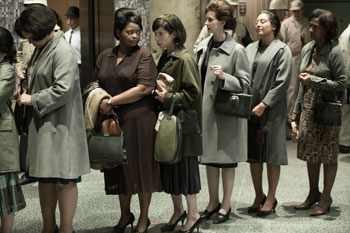 Sally Hawkins might have had her niggling doubts that fueled her to go beyond her own expectations but the filmmakers did not. 'With Sally, it's all about what's going on behind the eyes," says J Miles Dale. 'Guillermo del Toro knew he needed an incredibly instinctual actor to pull this off, and Sally Hawkins is able to do so much with the smallest of expressions or gestures, with the way she moves and even the tone of her silence."
Sally Hawkins might have had her niggling doubts that fueled her to go beyond her own expectations but the filmmakers did not. 'With Sally, it's all about what's going on behind the eyes," says J Miles Dale. 'Guillermo del Toro knew he needed an incredibly instinctual actor to pull this off, and Sally Hawkins is able to do so much with the smallest of expressions or gestures, with the way she moves and even the tone of her silence." For Sally Hawkins there was no other means to doing so except to dive in to the deep end with full abandon, navigating Elisa's blooming courage as well as a florid fantasy life that becomes unexpectedly real – with the most unexpected of partners. Working with Guillermo del Toro helped her to let go completely and submerge herself.
'Being Elisa was an incredibly internal kind of journey, but Guillermo del Toro is so inclusive and so values your creativity as well, and that he really helped," Sally Hawkins explains. 'He has such a powerful vision that whatever your fears are, he just takes them away and says -let me worry about that.'"
Her fears were lifted, but the demands remained at a high watermark. 'Unless Guillermo del Toro can feel your heart, he won't be satisfied," Sally Hawkins elaborates. 'He wants to be moved in every frame. But I think that is a kind of gift to an actor. He invites you to rise to the very high level of his imagination."
Sally Hawkins had a steep learning curve to begin with. She began taking ASL classes and dance lessons well before rehearsals began. She also began feeling out the way Elisa moves, her lightness on the earth. 'To me, it seemed she is always floating, always in a kind of dance, so I wanted to get at that sort of otherworldly feeling in her physical being," she describes. 'Everything about Elisa is so delicate, I felt even her sign language should be delicate and seamless and in sync with her being."
Her aim was total fluency in ASL. 'I wanted to learn enough so that if Guillermo del Toro wanted to go in another direction, we would be free to play around and it would always be natural to me," she explains. The sign language and the movement were challenging, but Hawkins says the outsized crux of the role was finding Elisa's 'voice" without any physical sound to give the audience. She had to find a more primordial yet effective ways to communicate – especially because Elisa is someone with a lot to say.
Sally Hawkins reflects: 'I had to explore all these very different relationships she has with very different people – with Giles, Zelda, Strickland and the creature -- each with such different kinds of chemistry … but explore all that without vocalizing, knowing that the emotion had to be completely authentic and true."
Part of that authenticity meant digging into why Elisa would risk so much for a creature whose past is inaccessible to her, whose very experience of life is a mystery – and digging into the valor that love unleashes in her. Sally Hawkins says, 'She decides nothing can stand in her way. As soon as she senses their connection, not trying to help the creature would be a kind death for her. It just seizes her by the heart and there's really nothing else she can do.
She just knows she has to save the day. I think it can overtake you when you're in that frame of mind." Elisa goes further than she could have envisioned. 'I think it takes her by surprise that she has this incredible steeliness," Sally Hawkins observes. 'She becomes somebody she didn't know she was, and sees all that she is capable of."
The remaking of Elisa's world starts when she first spies the creature in his transport chamber – and immediately realises there is something very much alive within. Few details are known of the creature, only than that he is likely the last of his kind; that local people in the Amazon worshipped him; that he carries a marvelous lung structure allowing him to breathe on land, a potential boon for the Space Race; that the Soviet military wants to possess him too; and that, unsettled by his intelligence and physical oddity, the man who captured him believes the creature to be a grave danger to humanity.
But Elisa sees none of that when she sets eyes on the iridescent beauty in chains – to her, he is sheer loneliness and that makes him instantly worthy of her attention.
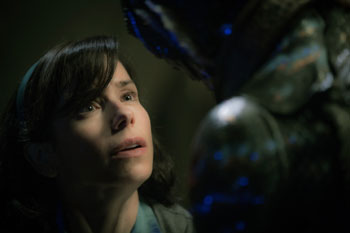 The Cold Warrior
The Cold WarriorThe man who hunted the amphibious creature deep across the Amazon with relentless determination is Richard Strickland, a steel-jawed, righteous, ambitious government agent who views his unusual quarry as nothing more than a ferocious beast to be manhandled into submission – and a ticket to his promotion.
Taking the role is one of the most sought-after actors of the current era: two-time Oscar® nominee Michael Shannon, renown for the intensity with which he's latched onto psychologically complex roles in such films as Take Shelter, Nocturnal Animals, Midnight Special, Revolutionary Road and 99 Homes.
'Strickland is a guy caught up in the whole mindset of the military-industrial complex, and he is trying to rise up in the hierarchy. The paranoia of the Cold War has become part of him," says J. Miles Dale.
Guillermo del Toro sees Shannon as having mesmerizing contrasts - exactly what he needed for Strickland. 'Michael has the incredible precision of a classical English actor and at the same time the impulsiveness and immediacy of an American actor," observes the director. 'He's also capable of giving humanity to the most heinous of villains. I didn't want Strickland to be just the bad guy. I wanted him to be a guy you almost feel for because he is himself a victim of the system and his times. I wanted you to him go through things you wouldn't normally see a villain go through: self-doubt, reflection and despair. Michael has all those moments in the movie."
Dark as Strickland is, Guillermo del Toro feels a kinship with him, knowing what it's like to traverse through a rigid world. 'Strickland is a very sad character to me. He's a guy who started with full belief in his country and in doing the right thing. Then he realises how little it takes for people to dislike and abandon him. I think this part is autobiographical because the movie business is exactly like that," he confesses. 'I've been on the other side of the conversation Strickland has with the General."
The lure for Shannon was the chance to take his own trip inside one of Guillermo del Toro's intricate universes. 'When I met with Guillermo, he said this film was his dream project -- and I thought it would be foolish to pass up an opportunity to be part of his dream project because he is such a big dreamer," he explains. Shannon expanded Strickland out from the archetype of the sturdy, unquestioning G-man of the 60s. 'I think Strickland wants to be strong, invulnerable and devoid of mistakes, with that American gung-ho drive, but he is also broken down by all that. The tough shell he maintains takes a lot of energy and behind it lies anxiety, doubt, stress and fear, which is ultimately revealed throughout the course of the movie."
The stress Strickland feels finds a threatening catharsis in his leering advances towards Elisa, who he otherwise views as his low-status lackey. 'I think Strickland is attracted to Elisa because of her vulnerability, and because she can't talk, but also because she's the exact opposite of him. In an alternate reality, maybe Strickland wishes he could be more like her than he is like himself," muses Shannon.
The collaboration with Sally Hawkins had an electric quality from the start, with each etching their characters to the point that the tension between Elisa's buoyancy and Strickland's dread could be cut with a knife. 'I've been a fan of Sally Hawkin's ever since I saw her in Happy Go Lucky, where she really knocked me out, so I was eager to work with her," he says. 'It's so challenging playing a part without any spoken lines. Yet she is able to communicate even more deeply like that and it was amazing to see."
Sally Hawkins, too, found the yin and yang contrasts between their two characters a creative charge. 'Elisa can see straight through Strickland for what he is and it was just electrifying to play that especially because Michael is so terrifying," she says. 'He's like this pressure cooker that explodes - but Elisa always holds her ground with him and that felt so empowering."
For the creature, Strickland is an existential threat. 'Strickland sees my character as a freak and because he doesn't understand me or even tries, he revels in my torment," says Jones. 'He's sort of the quintessential bully – the guy who sees something he's ignorant about and wants to push it around. The interesting contrast is that Michael is an extremely delightful person in real life but on film, he finds the darkness of a man as no other actor could. He's so intense, I don't know if I ever even saw him blink!"
Says Shannon of how Strickland views the creature: 'Strickland has seen to the creature's capture and he's hoping that will translate into big things. I think the creature gives him a sense of accomplishment. But he also uses him to vent all his most pent-up, poisonous feelings."
Most of all, Shannon enjoyed the creative bond with Guillermo del Toro. 'Guillermo del Toro really brings you into the creative process. And I love that he never stops working. When he's not shooting, he's editing on the monitor or listening or thinking. Every atom of his being is always on the hunt for opportunities, because he doesn't want to take anything for granted. That's a good fit for me, because I feel that same way."
Working closely with Strickland is David Hewlett (Rise Of The Planet Of The Apes) in the role of Fleming, the head of lab security who has no intention of letting things get out of control. As Hewlett describes it, 'Fleming is a key part of the hideous government world that this beautiful creature is thrust into. I think Fleming is actually quite a weak person because he stands silent while wrong is going on around him. He thinks he's on the top of his game but he's actually ineffectual."
David Hewlett especially loved the close-knit ensemble that formed among the actors. 'Octavia is a dynamo and I'm a jerk to her character, but she's just so hilariously lovely in every scene, it was a challenge for me not to smile," he comments. 'Sally Hawkins was another plane – I feel it almost hurts to watch her. And then Shannon is able to make every single moment he's on screen compelling and terrifying."
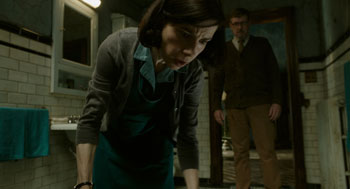 Elisa's Allies
Elisa's AlliesOnce Guillermo del Toro knew he was writing a love story, the characters took shape: Elisa and her two true friends, Giles and Zelda – were always interlinked in his mind. 'Together, the three make up a single character for me, as if they're different parts of the same brain. All three are marginal and invisible for different reasons -- one for race, one for sexual orientation, one for disability – and then they get together and give it to the man. The lab thinks they're fighting powerful Soviet spies, but I love that they are really fighting two cleaning ladies and a gay artist."
Before Elisa meets the creature, her loneliness is kept at bay by her neighbor and dearest friend in the world, Giles, an equally lonely, down-on-his-luck ad-man and avid movie musical lover. The character takes on a quietly growing strength as portrayed by Academy Award® nominee Richard Jenkins (The Visitor, Let Me In, Olive Kitteridge) - who says he jumped at the chance to be part of 'a beautiful, beautiful story."
Jenkins especially relished his first chance to work with Guillermo del Toro. 'To me, he's like an old master with a vocabulary all his own. He's also like nobody else I've worked with," the actor elaborates. 'He creates stories that feel real but also have something more going on, something that speaks to life and art and love. He's totally singular and that's why all of us on set were ready to go to the wall for him."
Guillermo del Toro had a gut feeling that there was more to Jenkins than has yet been seen on film. 'I felt he could be not just a great character actor but a true leading man. For Giles, I needed someone of great elegance, someone whose symbiosis with Elisa feels second nature. They're not lovers, but they deeply love and protect one another. They are simply one of those pairs of people who know they belong together in the world," describes the director. As a gay man in the intolerant 1960s, Giles has few outlets for his inner emotional life, which was key to slipping into the skin of a character who chafes ever so quietly against the times. 'I told Richard I wanted Giles to be someone both hiding and defiant, a strong guy in a vulnerable position," describes Guillermo del Toro. 'And he was just completely real, completely there, coming to part from the inside out."
With Giles frustrated by an art career seemingly going nowhere, his great escape lies in the Golden Age of movie musicals, an age that was fading by 1962 but the remnants of which Giles hunts for regularly on his TV, with Elisa in tow. 'I think Giles loves the idea of a perfect fantasy world," Jenkins observes. 'He doesn't really paint as an artist anymore and now he's painting just to try to make ends meet, so musicals are where he lives. That's why Elisa's journey becomes a journey of salvation for him as well."
Indeed, when Giles encounters the creature, the creative fire that had gone out in him reignites. 'The creature has an effect on everyone that he comes into contact with," notes Jenkins. 'With Giles, there is a sparking of his love of art because of course he wants to paint this remarkable, mysterious being."
Jenkins adored working with Sally Hawkins, especially because they had such one-of-a-kind form of communication between a man desperate to talk to someone and a mute woman. He says of Sally Hawkins: 'This is her movie, and I can't think of anyone else who could have played this part. I also think she has no idea just how good she is." Sally Hawkins felt an equal pull towards Jenkins. 'I've always wanted to work with him," she says. 'I found him both smart and free. Every take is different with Richard every time, yet each time it's fantastic. He taps into something so vulnerable in Giles. His willingness to go to deep places was a great joy for me."
The only other person to whom Elisa confides is her co-worker Zelda, a veteran cleaning lady at the lab who has come to not only comprehend Elisa but to gossip, share and unite with her. Taking the role of the confidante pulled into Elisa's scheme is Octavia Spencer, an Academy Award® winner for her supporting role in The Help and a recent nominee for portraying real-life NASA mathematician Dorothy Vaughan in Hidden Figures.
It was the look in Spencer's eyes Guillermo del Toro had in his mind when he wrote the part for her. 'A lot of casting for me is in the eyes because 50% of acting is listening and looking. Each character in this film has a certain way of looking and I felt I needed Octavia's eyes," he explains. 'She has a very powerful gaze. She is so entirely human and represents the best of what it is to be human with her spunk and her strength and her intelligence. When Octavia looks at you, you feel you are forgiven all your sins."
When she read the script, Zelda caught Spencer's imagination, especially as a woman who would have had little power, agency or recognition in those times, but proves to have a heroic streak she never had explored.
'Part of what's beautiful about this movie is that it is about the invisible people, the help. Even amid all this intrigue involving the government, spies, scientists and the creature, I think it's very interesting that at the forefront of the story you have a cleaning crew," Spencer points out.
Spencer zeroed in on Zelda's strengths, which are tested in the course of the film. 'Zelda is very opinionated and does not have a problem expressing herself," Spencer muses. 'I would say if Elisa is the heart of the film, Zelda is kind of the muscle at least in their world of the cleaning crew."
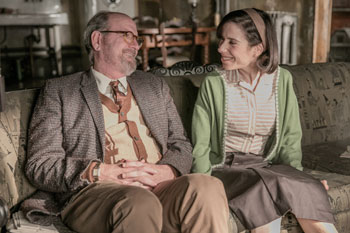 There is also a symbiosis that occurs between Zelda and Elisa, with each bringing a strong suit the other needs.
There is also a symbiosis that occurs between Zelda and Elisa, with each bringing a strong suit the other needs. 'My character's always talking, whereas Elisa uses her silence. Together we become one stronger unit, and with Sally that all happened in a very seamless way," Spencer says.
Hawkins and Spencer have an off-screen friendship that translated perfectly into Elisa and Zelda's tacit affection. 'Octavia's a dear friend so it felt natural and right to do this with her," says Sally Hawkins.
'Octavia's super smart and very, very funny and I love that she does not allow Zelda to ever be a cliché. Instead, her incredible heart comes out as you see Zelda going through a transformation of her own."
When it came to her initial encounters with the creature, Spencer purposely avoided even looking at early drawings – she wanted her reaction to be spontaneous. 'Guillermo del Toro was so excited to show us all sketches of the creature, but I didn't want to see anything until my character has to see it. I like to experience things in real time," she explains. 'When I did finally see it, it was just …wow, with the gills and scales, it seemed incredibly real."
The creature frightens Zelda enough to keep her distance, even as he magnetises Elisa. 'I think most people fear the unknown," Spencer comments, 'and Zelda is all about keeping her job. She knows the cleaning staff is not supposed to pay attention to the secrets there. So she tries to ignore the creature, seeing him as more a -thing' than a person, until she realizes her friend is in love and that changes everything."
A third character plays a hazier role in Elisa's life: Dr. Robert Hoffstetler, the marine biologist tasked with studying the creature's distinct lung structure – who for better or for worse becomes aware of Elisa's furtive link with the laboratory's top secret captive, and misinterprets her intentions.
Portraying the man of science torn between duty, country and his admiration for the creature is Michael Stuhlbarg, known for a diverse range of roles including in the Coen brothers' A Serious Man, Woody Allen's Blue Jasmine, Danny Boyle's Steve Jobs and HBO's Boardwalk Empire.
After seeing him in several of those, Guillermo del Toro had written down Stuhlbarg's name as someone with whom he wanted to work. 'I saw in him the ability to transform from a killer to a saint to a tragic figure and I knew he could create a composite character like Hoffstetler, who is on the one hand a very capable spy and on the other a compassionate, altruistic scientist capable of real sacrifice," he explains. 'He's the guy with the strongest principles because he takes an enormous risk to do what's right."
Hoffstetler is beset by clashing agendas. 'He has a complicated history," Stuhlbarg notes, 'but his first love is science and as he becomes more fascinated by the creature, I think he also falls in love a bit with him as well. They're both alone and maybe they recognize that in each other."
To give Stuhlbarg a lot to chew on, Del Toro offered him a deep dossier on Hoffstetler. 'Guillermo del Toro wrote for me this whole beautiful biography of who he thought this man was. It started from his youth in Russia, the kind of training he would have gone through to be in his position and also his passion for marine science," Stuhlbarg explains. 'He is caught between the Soviets and the Americans who care more about stopping the other from getting this magical creature than learning from the creature. But Hoffstetler realizes what he wants most is to save the creature's life."
Stuhlbarg was by no means fluent in Russian, which triggered a rapid-fire series of lessons in what is widely perceived as one of the globe's most perplexing languages to pick up. 'I'd actually taken Russian for six weeks in college and spoken Russian here or there in plays. So I was a bit familiar with the flavor and rhythm, but it was a long learning process. When production began, I was one of the first main characters to have a speaking scene and it was in Russian so it was trial by fire. I just threw myself in and it seemed to fly. I was delighted that I could to find a way inside Hoffstetler while doing so."
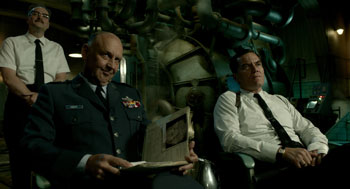 The Heart Of The Creature
The Heart Of The CreatureTaking a role that exists on the border between human, animal and myth is Doug Jones, who utilised both a meticulously-designed prosthetic costume and an extraordinary knack for physical expressiveness to forge the creature. Jones has a rare skill set, having worked repeatedly with Guillermo del Toro embodying his creations. Jones was the unforgettable Pale Man in Pan's Labyrinth, Abe Sapien in the Hellboy series and an ancient vampire in 'The Strain." But, like Hawkins, he never imagined he'd be the lead in a love story.
Says Sally Hawkins of Jones: 'Doug gives such an ingenious and beautiful performance and it had to be, because it's such a fragile thing we explore. We're two different species falling in love, but it had to feel real, and it had to be right. Luckily, I couldn't help but fall in love with Doug the way he embodied this."
There was never a crumb of doubt in Guillermo del Toro's mind that Jones would be the creature. 'We've been working together for 20 years and he's done some of the most crucial roles in my movies," Guillermo del Toro notes. 'He is one of the few guys who does creatures who is also a full-fledged dramatic actor. Often those are two separate gifts, but Doug has them both. He's a fantastic actor with or without makeup."
Guillermo del Toro adds: 'If you don't have an actor inside the creature's suit, you don't have a movie – and Doug is not a performer, he's an actor. I think of such moments as when he enters the movie theater and you realize the creature has never seen a movie before. Those are actor moments. I also remember before Richard Jenkins did the bathroom scene where he is getting to know the creature, Richard was worried he would be acting with a monster suit. Afterwards, Richard came to me and said -the moment you said action, I was in front of an ancient water god.' He felt all the pain and the confusion of the creature in Doug."
The only way in for Jones was a kind of imagination-fueled empathy, trying to intuit in his bones what life might be like for a keenly intelligent, amphibious creature hunted and dragged from its home to be studied by an alien species. 'He's very, very alone because he's the last of his species," Jones describes. 'He's also never been outside his river so he doesn't understand where he is or why. He's being tested and biopsied all because the government thinks, -we're going to use this thing to our advantage somehow.'"
But there is much more to the creature than the government agents can see. Jones perceives the enigmatic character as having a unique power to reflect people's desires back at them. 'Even though he's this freak of nature, he has an angelic kind of quality," he observes. 'He comes into people's lives and he seems to expose and amplify whatever is going on inside a human being."
As he seeps into Elisa's life, emotions unspool for both of them. 'Their communication is by necessity beyond words, entirely based on vision and feeling," Jones muses. 'Both characters are out of their element in the larger world but when they're together that disappears."
Physically, Jones used an image that Del Toro gave him to base his movements around: 'He said the creature has the bearing of a sexy, dangerous toreador - but with the fluidity of the Silver Surfer."
Once he started working with Sally Hawkins, rehearsing for a month before shooting began, their characters moved from the abstract to the alive. 'It was just gorgeous to explore with Sally Hawkins how much you can say to one another without any verbal dialogue," Jones says. 'And then you see how the power of their love inspires Elisa to buck the system, to step way outside her comfort zone."
Their love scene took Jones himself way out of his comfort zone. He admits he never foresaw doing a sex scene, no matter how artfully, in a monster suit -- but it also took him into a place of pure physical communication.
'In that scene, I'm thinking as a being who's never before experienced touch or intimacy. He and Elisa are both experiencing this for the first time, so it has a very unique kind of innocence."
Jones especially relished the unbreakable trust he found with Sally Hawkins. 'We're both playing such unconventional characters without any precedent so we bonded over that," he notes. When the camera rolled, their connection was palpable. 'I would get so lost in watching Sally that I'd forget what I was doing. There's something so real, so raw about Sally, I just fell for her, much as the creature does."
Octavia Spencer, who plays Elisa's friend and coworker Zelda, recalls the sudden emotions of seeing footage of Elisa and the creature interacting for the first time: 'It was so beautiful and touching, I didn't realise I would have the type of response I did: I just started sobbing watching it."
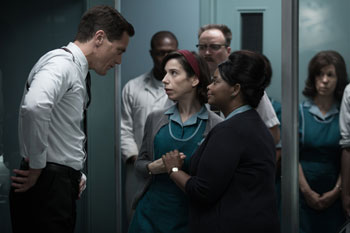 Amphibian Man: The Creation
Amphibian Man: The CreationThere have been human-fish hybrids or mermen seen on screen before – including Guillermo Del Toro's own Abe Sapien from Hellboy – but for the creature in The Shape Of Water, Guillermo del Toro wanted to leave all predecessors behind. He envisioned raising the bar to a new level of realism, crafting a being of such biological plausibility it might inspire a human woman's mad passion.
Three years before The Shape Of Water began shooting on sound stages in Toronto, del Toro hired Guy Davis and Vincent Proce to begin design work on the lab and the water cylinder. The next year he hired two sculptors, David Meng and Dave Grosso to begin working on the design of his Fish Creature at his Bleak House workshop at his own expense.
Guillermo del Toro was so committed to getting the creature right, he financed the design of the creature from his own pocket, spending hundreds of thousands of dollars in a process that took some 9 months of gestation. 'I knew I wanted the creature to feel real but at the same time for it to be beautiful which is a very hard line to tow," confesses Guillermo del Toro. 'I knew it was going to take a long time, so I didn't even put it in the film's budget. This is truly the hardest creature design I've ever done."
Early on, he assembled a crack team of artists who are pros at infusing life into the imaginary, including Shane Mahan of Legacy Effects, a creature designer extraordinaire and visual effects supervisor known for his awardwinning work bringing the superhero Ironman to life and for Pacific Rim; and Mike Hill, a renowned sculptor who specialises in ultra-realistic models of monsters from classic horror movies and has worked on such films as The Wolfman, Apocalypto and Men In Black 3.
The team worked tirelessly from sketchbook to maquette to the fully-realized creature suit that transformed Doug Jones. Says Sally Hawkins of what they achieved: 'I feel the creature is one of the most beautiful things I've ever seen. I had to be reacting to someone who feels alluring to Elisa and because of their work that came naturally. I didn't see Doug at all; I saw this incredible, mysterious specimen. Others might see a monster but Elisa sees something else entirely and that comes across."
Guillermo del Toro had his own way of testing whether the design was attractive enough. 'Every night, I took it to my home and got the female vote: enough ass or not enough ass, enough abs or more abs, shoulders bigger or slimmer? It just had to be a creature you could love fall in love with."
The initial inspiration for the creature came directly out of nature, with his bioluminescent skin, layered eyes and strong, sucking lips merging into a sleek, humanoid-style form. For those whose love is sculpting new life forms, the proposition of creating something so original was jaw-dropping.
Explains Shane Mahan: 'The idea from the beginning was to really push the idea of an aquatic form of life that has existed for millennia, to make it feel like a living creature from the sea with the kind of shifting, phosphorus colors you would see in tropical fish, but in a fleshy form that is compelling."
Looking for someone to blow the whole process open, Guillermo del Toro recruited Hill, having recently been wowed by his life-like monster sculptures at a horror film convention. 'Mike has a connection with monsters that is uncanny, and I thought we needed that level of insight," says the director. 'The difficulty with this creature is that we were not just sculpting a creature – we were sculpting a leading man."
Hill recalls the mission Guillermo del Toro set for him: 'He said he wanted me to give the creature a soul. He wanted it to be something a woman could fall head over heels for in every way. So I started sketching a handsome looking version of a fish man, giving him kissable lips, a square jaw and doe eyes and I went from there." The process got so intense, Hill spent night and day collaborating with Del Toro on clay sculptures, each sketching and scratching and revising the forms over and over. 'After weeks and weeks and weeks of sketching with the clay, we finally nailed it," Del Toro recalls.
The creature was now reinvented in a more sinewy form. 'I wanted to make him a bit more caliph like, and because Doug is so slim, I thought let's not waste that, and let's not build bulk," explains Hill. Hill and Guillermo del Toro perused an encyclopedia's worth of real-life fish as they worked. 'We wanted him to look like something that you might see washed up on the shore of a beach and at first think, oh, that looks kind of like a fish, so it was important to use realistic fish colors that are familiar to people," Hill says.
The enchanting tropical lionfish, a vibrantly colored, venomous creature native to the Pacific became the model for how the creature would eat – with its internal membrane that allows the fish to swallow its food in record time. Hill also looked to the natural world for the creature's translucent bioluminescence. 'People with aquariums are often attracted to glowing, see-through fish so we wanted to echo that idea," he elaborates. 'Later, Legacy came up with a way to re-create that idea in an opaque suit that looks fantastic."
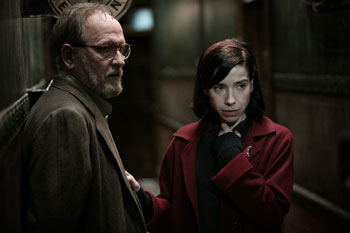 Even with the clay designs completed, only half the work was done. The next step was equally tough: turning the models into a series of practicable latex suits that a human being could move inside. Legacy transformed Hill's maquettes into a magnified, digital image, which was then sculpted further, etching in more muscularity and vascularity. Work also began on the creature's facial elements, especially his eyes. Recalls Mahan: 'One of the early conversations was that Guillermo del Toro wanted the eyes to be changeable on set in order to change the mood or look of the creature. Since you can't take Doug's makeup off to change them, we ended up coming up with a magnetic system to interlock the eyes. It was the only solution. Once we were shooting, we would change the eyes four or five times a night."
Even with the clay designs completed, only half the work was done. The next step was equally tough: turning the models into a series of practicable latex suits that a human being could move inside. Legacy transformed Hill's maquettes into a magnified, digital image, which was then sculpted further, etching in more muscularity and vascularity. Work also began on the creature's facial elements, especially his eyes. Recalls Mahan: 'One of the early conversations was that Guillermo del Toro wanted the eyes to be changeable on set in order to change the mood or look of the creature. Since you can't take Doug's makeup off to change them, we ended up coming up with a magnetic system to interlock the eyes. It was the only solution. Once we were shooting, we would change the eyes four or five times a night." The most minor seeming details – for example, creating a working set of gills for the creature – garnered tremendous time and thought. Says Mahan: 'His gills were especially challenging because we were dealing with a lot of water in some scenes. But they were also exciting, because the gills gives the creature an additional way of reacting without words and we could use Doug's breathing to enhance emotions like excitement, anger or affection." As early renditions of the suit were put through their paces, Guillermo del Toro was a constant driving force for the Legacy team. 'He has a love for our craft that is infectious," says Mahan. 'He would meet with us anytime, late on a Friday night or on a Sunday, and he was involved at every turn. It's very rare that you find that kind of interest in being so super refined and for us, that kind of obsession is inspiring. You end up wanting to invest more and more into making it as great as it can possibly be."
Finally, four spectacularly intricate suits, each capable of getting waterlogged, were made for the production. Says Guillermo del Toro: 'Shane and the whole team at Legacy were incredible partners in the design. They were instrumental in developing the color, solving the logistics and reconciling the beauty of the design Mike and I did with something that would be truly functional."
Painstakingly constructed as it was, the suit proved to be a daily challenge for Jones, who had to not only learn to live in it, but to fall in love inside it. Legacy made it as pliable as it could possibly be, though it still had the quality of a constricting vise. 'The suit is super tight and inside it there are actual corsets to make it even tighter. But we segmented the abdominal plates so that they do give and move a little bit. It's not solid, so it can create the graceful motions the story demands of Doug," Mahan says.
The skin-tight fit and athletic nature of moving in the suit pushed Jones to 'get into the best shape of my life" at age 56, he says. 'I knew this would be my most physically demanding role, so that spurred me. Just wearing the suit, which has foam latex rubber and silicone designed to always spring back to the position it was sculpted in, was an intense work out. Every movement is like doing a pushup or a pull-up."
Jones's extensive transformation also meant spending two to four hours daily in the makeup chair. In some scenes, he was entirely blinded by prosthetic eyes. The suit also took four people to hoist Jones into it. 'It was a daily 19 comedy of tugging and pulling and baby powdering as well as shoving, shifting, zipping and snapping as four grown men pulled on my arms and legs," Jones laughs.
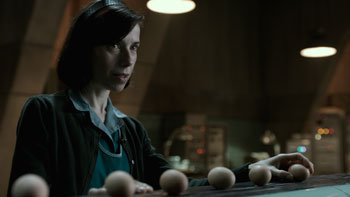 Shaping The Visual Effects
Shaping The Visual EffectsThe film's visual effects supervisor, regular Guillermo del Toro collaborator Dennis Berardi, became another key partner in crafting the creature's full existence. When Berardi read The Shape Of Water he says he was overcome with feeling – and also excitement about what lay ahead. 'I could see how my team could make a real contribution to the film's core emotional components and I was all in," he recalls.
Berardi began by creating an exacting digital double of Doug Jones in the prosthetic suit. 'Guillermo wanted the creature to not only be able to emote like Doug but to also move underwater in a certain way so we did a lot of early movement tests with our Animation Team at Mr. X and we got to the point where we could do a digital version of the creature that could match up with Doug's beautiful performance," he says.
Crafting the underwater movements was a research-intensive process that involved looking not only at Olympian human swimmers but such aquatic species as sharks, puffins, otters and penguins. 'We looked at anything that moves very gracefully through the water in order to base it all in reality," Berardi explains.
The result was a digital mirror reflecting Jones's powerful acting with the added dimensions of a creature that doesn't exist - the real and the unreal aligning in synch. Berardi even played with the creature's colors, shifting them with his mood. 'Our hope is that the audience can't distinguish at all between the digital version of the creature or the Doug Jones version. Doug's performance informs our animation and I think our animation has also informed how Doug was photographed. If the audience can't tell which is which, we will have succeeded," says Berardi. Del Toro's encyclopedic knowledge of cinematic history, especially monster movie history, was a constant resource. 'He knows creatures like the back of his hand," Berardi muses. 'I can show him any reference from any movie and he can destruct the method used to create it. So that gives him a unique ability to communicate what he wants based on stuff that he's seen and also what's in his mind. He gives you magical inspiration, then challenges you to bring your own ideas to the table, which is so rewarding."
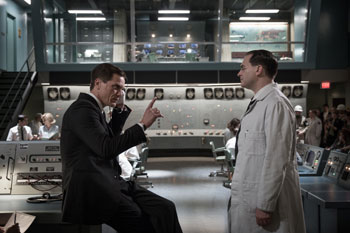 Shooting The Unreal For Real: The Cinematography
Shooting The Unreal For Real: The CinematographyThe Shape Of Water's shadowy atmosphere drops the audience into the depths of the story – and Dan Laustsen's creative cinematography was vital to achieving Guillermo del Toro's vision. 'The final design of the creature is done with light," Guillermo del Toro emphasises. 'If I did not have a D.P. who understood that it wouldn't work. Dan also understands it's not just about key light, cross light, rim light, etcetera. He's not technical; he's emotional. I think all great cinematographers are emotional. A great cinematographer is like an orchestra conductor – he transmits emotion with light instead of musical notes."
Laustsen recalls that as he read the script he wondered aloud: 'How are we ever going to shoot this?" He goes on: 'But then I talked to Guillermo del Toro and his vision was so strong, I started to believe it was possible. This film was both a big challenge and a fantastic experience for me."
The rich silence of the film's two leads especially tantalised Laustsen. 'That whole idea of two mute characters connecting is very cinematic," he muses. Equally inspiring was the idea of using a kind of visual liquidity to make the whole narrative ebb and flow like water. 'Everything's in motion in the film," Laustsen describes. 'Guillermo del Toro wanted lots of camera movement, and he likes very precise movement, so we worked with all kinds of cranes, dollies and Steadicams, and it was very exciting."
Laustsen put the much-loved Arri Alexa digital camera through its paces, using Arri/Zeiss Master Prime lenses, which allowed for maximum precision. He explains, 'Guillermo wants crisp, crisp images where everything is sharp, and you can really see the details with this combination."
Early on, Guillermo del Toro and Laustsen flirted with shooting the film in a classic black & white, but they reversed course – and both agree it was a catalytic decision. Working instead with monochromatic tones of color, they meticulously shifted light and texture to craft a more modern, yet desaturated look, full of deep-sea tones. Explains Guillermo del Toro: 'I knew I wanted the film to be monochromatic, so most of the palette is blues and greens with amber as a counter-balance. Red only comes in as the color of blood and love."
An almost architectural lighting design formed a centerpiece of the work. 'Dan is a genius with light," muses Guillermo del Toro, 'and he was able to light the film as if it was 1950s black & white even though we use color. The light is very expressionistic and full of shadows and I think feels very classic."
Lighting was especially vital when shooting the creature. 'He's not really a terrifying character, but he is fascinating and the camera is fascinated with him," says Laustsen. 'Is he an animal? Could you call him a person? In terms of the cinematography he had to be lit very, very carefully, because of course as an audience member you want to see every part of him, but we also wanted to keep him a bit mysterious."
For some of the underwater sequences, Laustsen went Old School, harking back to the technique of shooting 'dry for wet," creating the illusion of water. This involved utilizing heavy smoke, wind machines and projection to create a dripping, pulsating atmosphere akin to water --while allowing the actors to work with their eyes open, vital to their expressions. Says Guillermo del Toro: 'We did a lot of research on how to do dry for wet well – from how many frames per second to use to how you can create floating particles. We knew the key was to create a video projection of caustic light on the characters that is very operatic."
Recalls Doug Jones: 'When we did the dry for wet scenes, Sally Hawkins and I were working in fog with lights zigzagging around like waves. It was quite unusual, but when I saw the video playback, I was like, -dang that looks real.'"
Real water also played a role in the bathroom sequences, which meant challenging tank work. Summarises Laustsen: 'Shooting underwater is always a big challenge because of the lack of communication. But the underwater part of things was the really the least of our worries in those scenes. Most of all, we wanted Elisa to look amazing and the creature to look a little scary and the whole thing to be very, very romantic."
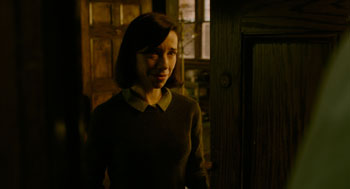 The Look Of Water: The Design
The Look Of Water: The DesignGuillermo del Toro is as much a world-builder as he is a director, and for The Shape Of Water, the world he wanted to create was a blend of historically authentic Cold War America with the patina of a timeless legend. The design was ambitious. Elisa might lead a quiet, nearly invisible life but she roams through realms that are epic: from the covert government laboratory where she works to the apartment leaking flickering light from a B-movie theatre below to the Maryland coast where the film reaches its climax. Like the fluidity of the camera, the design features curves and serpentines set against a world where hard lines can be drawn in men's minds.
Says J. Miles Dale: 'Guillermo del Toro is undeniably a grand visualist. From the sets to the costume to the camera, no detail is too small for his attention. So that also makes him a kind of catnip for designers. With Paul Austerberry, the process started early, designing the lab, Strickland's office and home, Elisa and Giles's apartments and the bathroom that becomes so important to the story. He spent a lot of time really nailing the palette, and it was the same with Luis's costumes. Guillermo del Toro always has very specific ideas about colors and textures and Luis just ran with that, coordinating with Paul and Dan the whole way."
For Guillermo del Toro, bringing in Austerberry – who is also working on the forthcoming Pacific Rim: Uprising – was a must. 'I fell in love with the fact that Paul has a very strong opinion of design, meaning he could counter anything I talked about with new ideas," Guillermo del Toro says. 'But even though Paul has great ideas, he's also very practical and that was important because this film had such a big scope, with complex sets and underwater shooting. He had to be able to orchestrate and manage all that."
Research and realism were the twin poles of Austerberry's work, which helped transport cast and crew. 'The sets were like stepping into a painting," says Sally Hawkins. 'That's what it felt like to me." Austerberry began by rooting his designs in the actuality of the early 60s, with its mix of futurism and sleekly functional mid-Century design. 'Guillermo del Toro and I talked about basing the design in reality so I started with a ton of research, looking through books and archives of all kinds of government research labs, pulling lots of references," he says. 'Guillermo del Toro always says you first need to make a place grounded in reality in order for it to become fantastical, so we were as authentic to the period as we could be in the story."
The laboratory, where the creature is housed in a secured, indoor pool, establishes the mood with its blending of emerging high tech with a timeless hall of horrors. 'We didn't want a lab that would come off too sterile and bright, which is what you usually see, so we went the other way with a laboratory where you feel lots of unsettling things have gone on in there and it has some dark history," Austerberry explains.
The creature's room is a maze of pipework, ducting and cylindrical chambers. Says Guillermo del Toro: 'For the creature's compound, I wanted the feeling of a dungeon with all the chains, surgical tables and the steampunk pipes. It is not a pleasant, well-lit lab - I wanted it to feel almost more medieval than modern to add to the fairytale feeling."
Continues Austerberry: 'The pipes you see look like heavy cast iron pipes, but they're all done out of Styrofoam. That set was such a complicated jigsaw puzzle, we were working on it right down to the wire. On top of everything else, we had to design everything to endure lots of water and steam and for a huge lighting job as well." Austerberry had in mind Brutalist architecture – the concrete-heavy, function-based style that flourished from the 50s to the 70s - for the compound. Searching for a less angular version, he found reference photos from a concrete French sanatorium that was more rounded. 'I didn't want hard, rectangular lines which felt too modern sci-fi," he explains.
Then there is the capsule in which the creature first arrives. 'It's described as an iron lung in the script so I pulled lots of historical references of iron lungs. There was one in particular Guillermo del Toro loved. He loved the color, the shape and language of the materials. It was one of the first things we designed actually because it took over 8 weeks to fabricate. The idea is that the chamber is on wheels so it can then be attached onto the larger pressurized cylinder in the laboratory to transfer the creature."
For the laboratory's NASA-like 'command center," Austerberry crafted a typically 1950s glass tile mosaic – but out of tile-board, which allowed for rapid deployment. 'I went looking in the research for 50s wall murals and I discovered a Lisbon tile mosaic that had a really amazing green-blue color palette that Guillermo loved. You see a lot of it because Strickland's office is so high up and otherwise fairly stark, but there's this beautiful color palette going on behind the big glass panes of windows."
Strickland's office floats above the command center, an eye in the sky, full of surveillance equipment. 'He overlooks the minions working for him through the glass via an early closed-circuit camera system we based on 1960s TV studio set-ups. When you see Strickland behind this wall of images it really speaks to how he sees himself as above everyone and privy to all information he can take" Austerberry reflects.
The laboratory's bathroom and locker room each host key scenes and these were shot in Toronto's massive Hearn Generating Station, an old power station that has become an icon of a bygone industrial age. 'We looked at Hearn because it has tiled rooms. Unfortunately, the tiles in Hearn are cream and Guillermo del Toro was like, -we can't have that color in this movie,' so we ended up still using it but hand-painting every tile to be in our palette," Austerberry relates. Austerberry especially loved designing Elisa and Giles's apartments sitting atop a classic bijou-style movie theatre. To forge the exterior, he used Toronto's Massey Hall -- a designated National Historic Site of Canada, which was designed in the neoclassical tradition by architect Sidney Badgley in 1894 and extensively refurbished in the 1940s to become a now popular performing arts theatre. Though it was never a cinema it evoked the elegance of an old movie palace and, with a lit marquee, fit the bill.
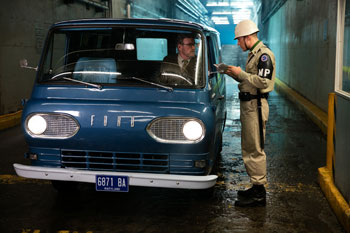 The interior is where Austerberry really took off creatively. Del Toro wanted Elisa and Giles's apartments to be two halves of a whole, much like their essence as friends, divided by an arched window.
The interior is where Austerberry really took off creatively. Del Toro wanted Elisa and Giles's apartments to be two halves of a whole, much like their essence as friends, divided by an arched window. The director describes: 'Their apartments are like two hemispheres of the same globe, but we lit each half differently. With Giles, even if the scene was at night we lit it like sunset in very warm tones. The color-coding of Elisa's apartment is aquatic, with cool lighting and lots of cyan. Hers is corroded by water, while his is not corroded at all. His is full of wood and golden light, very grounded colors because he is the grounding for Elisa, whereas Elisa's apartment has the magical light of the cinema below."
Elisa's apartment was a favorite of both director and designer. 'We talked a lot about the idea that once this was a grand room but at some point there was a fire and it never got repaired so it looks very aged with that patina Guillermo loves," says Austerberry. 'Guillermo del Toro brought us an image he had from a photography competition in India with an old lady in a darkened room with a really aged textured and a cyan blue wall in the background and that became a big inspiration."
The walls were a major focus and an exhaustive quest led Austerberry to a vintage Anglo-Japanese wallpaper pattern featuring little curves that subtly resemble fish scales, similar to an ancient Japanese engraving. He then merged that pattern over a faded cresting wave reminiscent of 19th Century Japanese artist Hokusai's iconic woodblock print, 'The Great Wave of Kanagawa."
'We had a scenic artist paint a beautiful version of the Great Wave in textured plaster and then we just layered and layered and layered over it until it's basically gone but you still sense there's this shape of water on this wall," Austerberry describes. 'Guillermo del Toro wanted the wall to be stark and subtle but to tell a little story if you knew what you were looking for. So that's how it became so finely detailed."
All of the walls in the apartment were created as 'wild walls," meaning they were all on quick-releases so that could be moved at a moment's notice to accommodate a roving camera. In addition, the windows each had to be plumbed for the deluge of rain that leads up to the film's climactic moments. When it came to the floor, Austerberry crafted leaks in the subflooring so that light from the cinema penetrates through, merging Elisa and Giles's daily life with the movie fantasies running down below.
Then came the most challenging set of all: the modest, retro bathroom, which is Elisa's oasis from the world – and then becomes the creature's refuge and the site of their deepening romance. Ultimately, Austerberry knew his set would become a pool. 'Our sets are generally made out of wood, Styrofoam and plaster. But for this one we had to make everything out of aluminum and Bondo instead of plaster because it all would ultimately be submerged in a tank. At one point, we actually lowered the sets slowly into the tank so that you can see the water rise. It was all very, very tricky to pull off," he describes.
Tricky as it all was, the pay-off was generous. 'Elisa's flat simply took my breath away," says Sally Hawkins. 'The richness of it and the colors – it was like working inside a poem or incredible piece of art." Adding to the production design, visual effects supervisor Berardi helped to place the story in a now-vanished 1960s Baltimore, recreating the city digitally from archival photos. 'The idea was that it should feel photo-real, yet with that fableistic component -- which is a tough balance to strike," Berardi notes. 'What helped is that Guillermo is so collaborative. Even when we came up with something pretty good, he was always asking -OK, what can we do now to make it great? What's the next level?'"
The fuzzy line between fable and reality is also woven into the fabric of Sequeira's costumes for The Shape Of Water. 'In Luis's work, every piece reflects the interior of a character," says Del Toro, 'from the beautiful shark-skin suit for Strickland that is almost James Bond perfect to Elisa's dresses."
Sequeira has worked with Guillermo del Toro on 'The Strain," but this process was new. 'On this film, we didn't have a lot of concept art so it all started from discussion on each of the characters and their different worlds. Hundreds of photos and images were collected and from that, we started really refining the look of each character as part of the storytelling," he explains.
Elisa's costumes were informed at once by her working-class status but also by a subtly buoyant aquatic theme. 'Elisa isn't a person who has a lot of clothes, so she needed just a few pieces, but very special pieces," says Sequeira. 'She is in blues and greens, watery colors, for the most part. There is a little red only near the end of the film, signifying a shift in her resolve."
Octavia Butler's Zelda is in contrasting colors. 'I wanted to do a kind of a bruised fruit palette for Octavia so it would feel very different from Sally's character and different from all the other female characters in the film as well," says Sequeira.
Sequeira's team did a lot of their own crafting, creating everything from Michael Shannon's hats to vintage shoes, jewelry and undergarments. 'One of the important things to Guillermo was that the clothing not only be accurate to the period but look as though it has lived a life," Sequeira says.
Watching his costumes in action on Austerberry's sets really brought it all home for Sequeira. 'That's the beauty of film - when the costumes combine with the hair, makeup, lighting, sets and the actors it becomes something magical," he says. 'Suddenly, it's 1962, only it's Guillermo Del Toro's unique version of it."
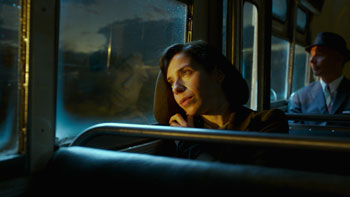 Dancing In The Deep
Dancing In The DeepThe film's entire collaborative circle – including cinematographer Dan Laustsen, production designer Paul Austerberry and costume designer Luis Sequeira – combined their creative energies for one of the film's most unusual sequences: a Golden Hollywood style song-and-dance number that could be out of a 1940s black-and-white feature but for the fact it features a mute cleaning lady and piscine creature. Like the classic movie musicals, the number is reserved for a moment in which emotions burst out beyond the boundaries of convention.
'The creature only knows about six words and Elisa wants to tell him, -you'll never know how much I love you,' so she wonders how do I say it? That's when she starts singing," Guillermo del Toro describes. 'I knew this was a big gesture for a film of this size and we would need to allocate the resources very carefully. So we had just half a day to shoot the musical number."
Rather than emulate the more static MGM musicals of the -40s, Guillermo del Toro looked to the more energetically fluid style of Stanley Donen, famed for his debonair symbiosis with Gene Kelly on such films as Singin' In The Rain and It's Always Fair Weather. 'Donen did all these sweeping cranes, so I thought I'm going to mix the aesthetics of a classical black-and-white musical with those cranes. It's a combination of the two styles – and it comes at a moment in the story when everything is so dire that it kind of breaks up that energy and sets things flowing into the last movement of the film," Del Toro explains.
The scene was literally like a dream to Hawkins, a dream she's had since childhood. 'I was obsessed with Fred Astaire and Ginger Rogers as a child," she notes. 'I watched nothing else. But I never thought that I would ever experience that kind of magical cinema myself. Yet here I was living that dream and I got to wear the most beautiful dress and glide into the air. Honestly by the end of the scene, I was so happy I felt I never needed to work again. I thought I might just go work in a bookshop for the rest of my life!"
Doug Jones was a bit taken aback by such an unconventional turn for a non-human character, but he knew it would work in Guillermo del Toro's hands. 'This movie musical moment is the most unusual I've had as a creature but it's one of those things only Guillermo could pull off," he reflects. 'I could not wait to do the scene. Sally and I were both a bit terrified and excited, but that only seemed to unite us more." Shot in color with vintage lighting, the sequence was later processed into a time-warping black & white. Meanwhile, Sequeira found joy in designing Elisa's vintage 1930s dress for the dream dance number. 'Ginger Rogers was the inspiration but then there was a lot of working with the intensity of the color and how it would respond to the lighting to really maximize the impact," he describes.
Guillermo del Toro also brought in a full orchestra for the number, but notes it was likely not what they were expecting.
'I think the orchestra probably thought they had been booked in a gig from hell because they come in with their tuxedos and their instruments and they sit down and then comes a fish-man and woman in a sequin dress and they start dancing," he laughs, 'but it was a great day."
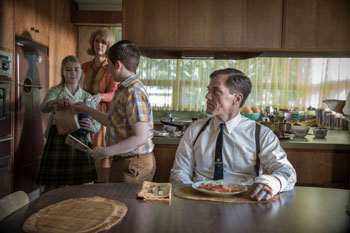 Sound Of Water: The Music
Sound Of Water: The MusicGuillermo Del Toro collaborates for the first time with Oscar®-winning composer Alexandre Desplat on The Shape Of Water – and both were immediately on the same page about all that the music might convey in a film where two characters use everything but words to connect to each other.
'This is probably the easiest relationship I've ever had with a composer because Alexandre truly understood the movie and its essence and his music is completely imbued with that," says Del Toro. 'A good composer flows with the camera moves and the emotion of the moment - and I find Alexandre's punctuation of those things is impeccable and never obvious. Great scoring always adds another layer to the story, and Alexandre knows how to integrate music with dialogue, action and sound design."
Desplat says watching an early cut of the film hit home with him in a deep way. 'I think it's a beautiful, beautiful love story – and I felt you could transpose this situation in the film to any type of difference between human beings. But the crucial thing for me creatively is that I was really stunned by the fluidity of the camera," he recalls. 'The camera never stops. It's always in motion so you have a sensation like water in the flow of the movie.
There's nothing more inspiring for music than a story that flows because you can just surf on it. This story was very special on that level."
As he began talking with Guillermo del Toro, Desplat discovered they both admire many of the same composers - especially Nino Rota, who composed for the Italian masters Fellini and Visconti, and George Delerue, who composed for Truffaut, Godard and won an Oscar® for George Roy Hill's A Little Romance. 'They were composers who never forced emotion," observes Desplat. They were always trying to bring true, deep feeling to their music without overdoing it. And that was the approach here. The music is not pushing you, not manipulating you. Rather, it's the music of Elisa's heart beating and that's what we were trying to achieve. It's not simplistic at all, but it's meant to be something simple in an organic way."
They chose to develop a distinct theme for each of the main characters in a back-and-forth process. For Elisa, Guillermo del Toro always heard a waltz, with its lively one-two-three rhythm and Desplat suggested the accordion as a vibrant and distinctive way to work with that idea … the Del Toro suggested adding a whistle. 'I always thought Elisa's rhythm and tempo would be very waltzy," says Del Toro. 'But I also felt we need something more than the accordion and I thought, why don't we use a human whistle? Whistling is not used enough in movies, but is eminently human. So we did it."
Desplat found the instrumentation brought him deeper into Elisa and her wellspring of vital energy. 'There's an innocence that we tried to capture with her thematic music. She's smart yet she's somehow innocent. She likes sex but at the same time she wants pure love. So there's something ambiguous about her, something romantic and lyrical, which was beautiful to play with in the music."
The fact that she is mute only made his compositions that much more significant. 'With a character who doesn't speak, you have more space," Desplat explains. 'You can expand the sound more and say things with many different colors in the instruments. In a way you can be more talkative musically."
For the creature's theme, flutes dominate. 'So much of the creature is about breath, about oxygen or the lack of oxygen, so flutes seemed to me to reflect the creature," says Guillermo del Toro.
Desplat ran with that idea. 'I suggested we change the lineup of the orchestra to have 12 flutes -- alto flutes, bass flutes and C flutes - but no clarinets, no bassoons, no oboes. There's very little brass, only in a few cues, so it's really the strings and the flutes that bring the qualities of fluidity and transparency that water has. We added to that some piano, harp and vibraphone, instruments that have a pearl-like quality."
Then, Desplat composed a love theme for the duo. Says Del Toro: 'We wanted the love theme to be very emotional, not sentimentally artificial, so it's a variation on Elisa's theme."
Guillermo del Toro doesn't usually attend recording sessions, but this time was different. 'Alexandre said to me I would love for you to be there to say -more emotion' or -less emotion.' And we had such a unique collaboration that I felt I was not an intruder into the process but could bring more ideas to it."
 The day of recording the orchestra was a highpoint for Desplat. 'I loved it," he says. 'Being on the floor with the musicians and sharing my ideas and adjusting things was a great pleasure. It's always amazing to hear an orchestra blowing your own music back at you."
The day of recording the orchestra was a highpoint for Desplat. 'I loved it," he says. 'Being on the floor with the musicians and sharing my ideas and adjusting things was a great pleasure. It's always amazing to hear an orchestra blowing your own music back at you." As for his rapport with Del Toro, Desplat says: 'For me Guillermo del Toro is as much as an artist as a director. It is the way in which those two things combine in him that makes his work so magical."
That rare combination is what gave the entire cast and crew the courage to take a dive into this underwater story of such swirling cultural, political and personal resonance. Sums up Sally Hawkins: 'Guillermo del Toro has a unique ability to go straight to the heart of things. He grabs you by the heart and doesn't let you go. That's the experience I went through making the film and I hope that's the experience people have watching it."
If I told you about her, the princess without voice, what would I say?
Would I tell you about the time...? It happened a long time agoin the last days of a fair
Prince's reign... Or would I tell you about the place?
A small city near the coast but far from everything else...
Or perhaps I would just warn you about the truth of these facts
and the tale of love and loss and the monster that tried to destroy it all...
-Giles, The Shape Of Water
The Shape of Water
Release Date: January 18th, 2018
MORE
- Mission: Impossible Fallout
- Glenn Close The Wife
- Allison Chhorn Stanley's Mouth Interview
- Benicio Del Toro Sicario: Day of the Soldado
- Dame Judi Dench Tea With The Dames
- Sandra Bullock Ocean's 8
- Chris Pratt Jurassic World: Fallen Kingdom
- Claudia Sangiorgi Dalimore and Michelle Grace...
- Rachel McAdams Disobedience Interview
- Sebastián Lelio and Alessandro Nivola...
- Perri Cummings Trench Interview



